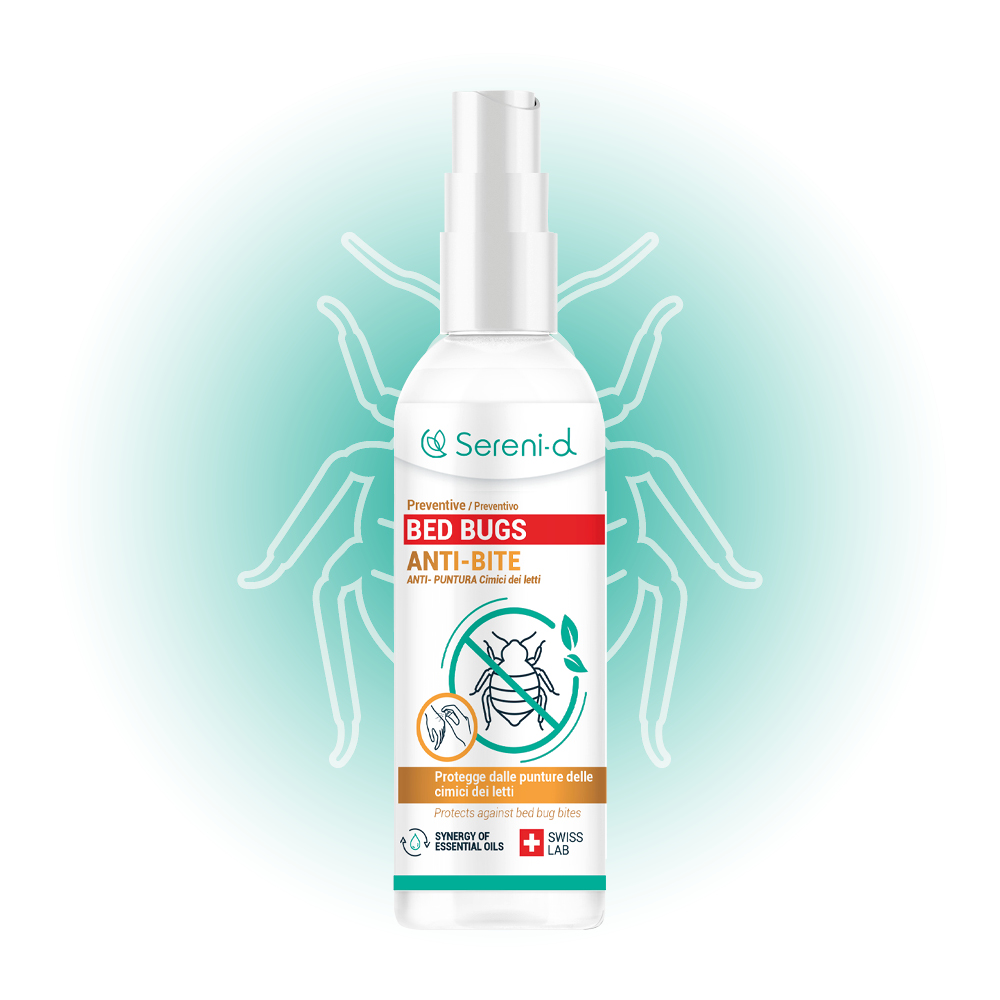Airbnb, hotels, bed and breakfasts – bed bugs are a growing problem. Unfortunately, these pests can ruin your holidays, not to mention the risk of bringing them home with you. If you travel regularly, prevention is better than cure. Here are some good practices to adopt before, during and after your stay.
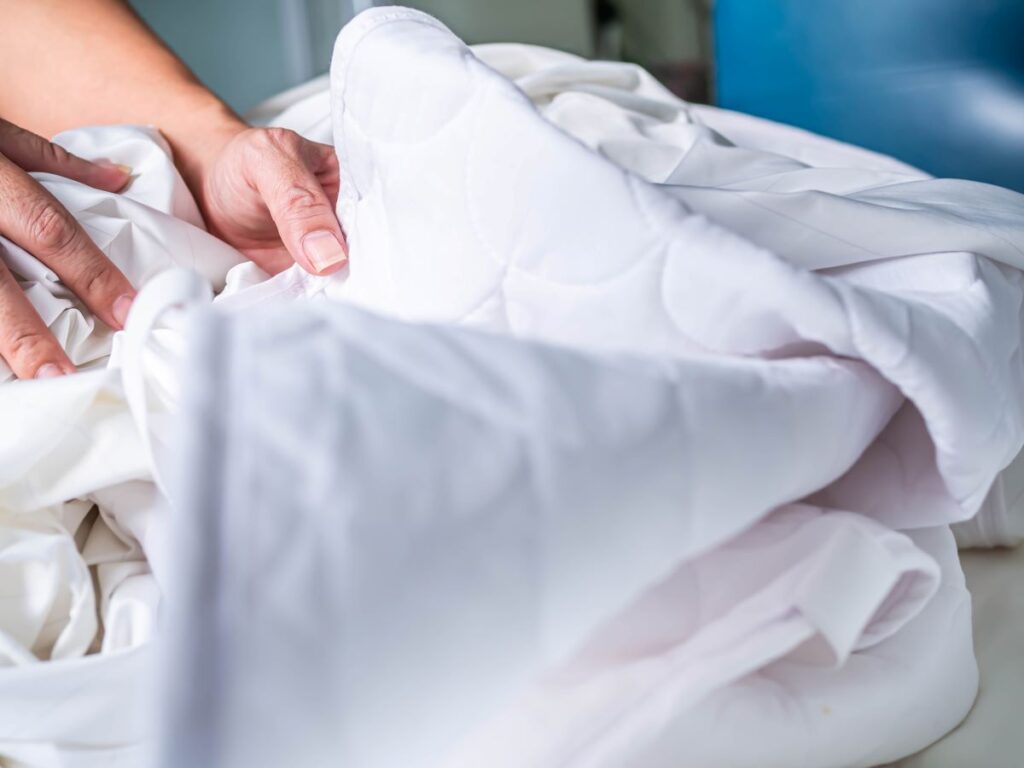
Find out about holiday accommodation before booking
Before booking a hotel, Airbnb or any other type of accommodation, it’s very important to check whether there’s a precedent for bed bugs. You can do this by looking at recent customer reviews.
Tip: when consulting Google and other reviews, type Ctrl + F on your keyboard and search for the word ‘drawing pin’.
Positive reviews of room maintenance are also a good sign of pest control.
You can also contact the hotel directly to ask if they’ve had any bed bug infestations recently. That said, there’s a good chance that the hotel will reply in the negative, to limit the bad publicity!
How do you know if there are bed bugs in your holiday accommodation?
Places with a high turnover of travellers represent a high risk of bed bug infestation. This can be the case in hotels, even 5-star ones (the presence of bed bugs is not linked to the issue of hygiene), mountain refuges, youth hostels, bed and breakfasts, etc. How to detect the presence of bed bugs?
Start by checking online bed bug registers or reviews of the accommodation before you book it. Once there, leave your luggage in front of the room door and carry out a general inspection of the premises. If you discover bed bugs in your accommodation, report them immediately to the staff so that they can implement the necessary treatment to eradicate them. There are several signs that bed bugs may be present.
➡️ See also : Bed bugs in hotels: what to do
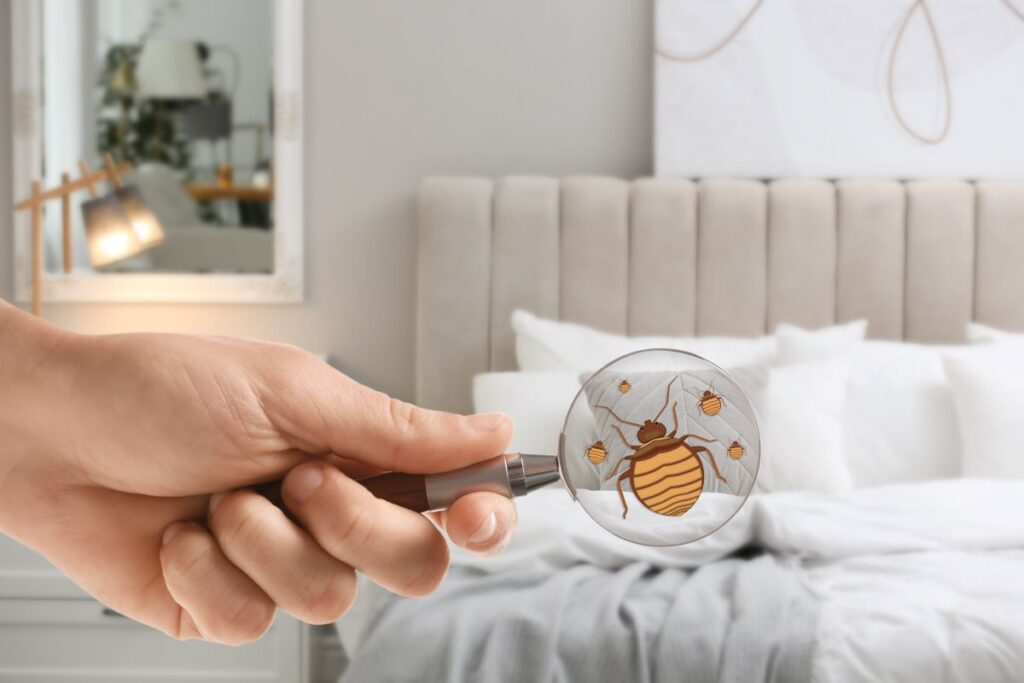

· Inspecting bed bug hiding places
Start by checking the bed by lifting the sheets and inspecting the mattress, especially the seams and folds. Lift the mattress and check the bed base for live insects, moulting skins and eggs. Check behind the headboard, bedside tables, behind furniture and pictures, in the curtains, under the carpets and in all the dark places (cracks, skirting boards, etc.).
· Bed bug marks on the wall
You can also detect the presence of bed bugs by inspecting the walls, especially at the headboard or against the bed, skirting boards, sockets or in cracks and crevices in the bedroom. Bed bugs leave black spots, which are a sign of their excrement. These clues can point you in the direction of an infestation.
➡️ See also: Recognising the marks and stains of bed bugs
· Bed bug marks on mattress
Inspect the mattress and bed linen for small bloodstains. Bed bugs feed on the blood of their prey while they sleep, biting them. A bed bug takes between 10 and 20 minutes to draw blood from a sleeper. So it’s not uncommon for people to squash bed bugs while they’re sleeping, leaving trails of blood on the sheets.
· Recognising bed bugs
Bed bugs are visible to the naked eye, and are about the size of a flattened apple seed, or 4 to 7 mm long when fully grown. Bed fleas are generally brown in colour, but can be red when gorged with blood. The insect is flat, oval-shaped and wingless. A female lays between 200 and 500 eggs in her lifetime. The eggs are whitish, about the size of a pinhead, and look like translucent grains of rice.
Finally, bed bugs come out at night to feed on human blood, while during the day they remain hidden in their hiding places (wall cracks, behind furniture, in mattress seams, in night table drawers, behind the skirting boards, etc.). To find out more, see our dedicated article on how do you know if you have bedbugs?
· Bed bugs: symptoms
The presence of bed bugs can be detected after a night spent in an infested hotel. In fact, if you wake up with spots clustered on your skin in a row in the form of red, raised spots, you may be the victim of bed bug bites. In most cases, their bites cause itching, especially in the morning. These may disappear after a few hours. In some people, bedbug bites can cause allergic reactions such as hives.
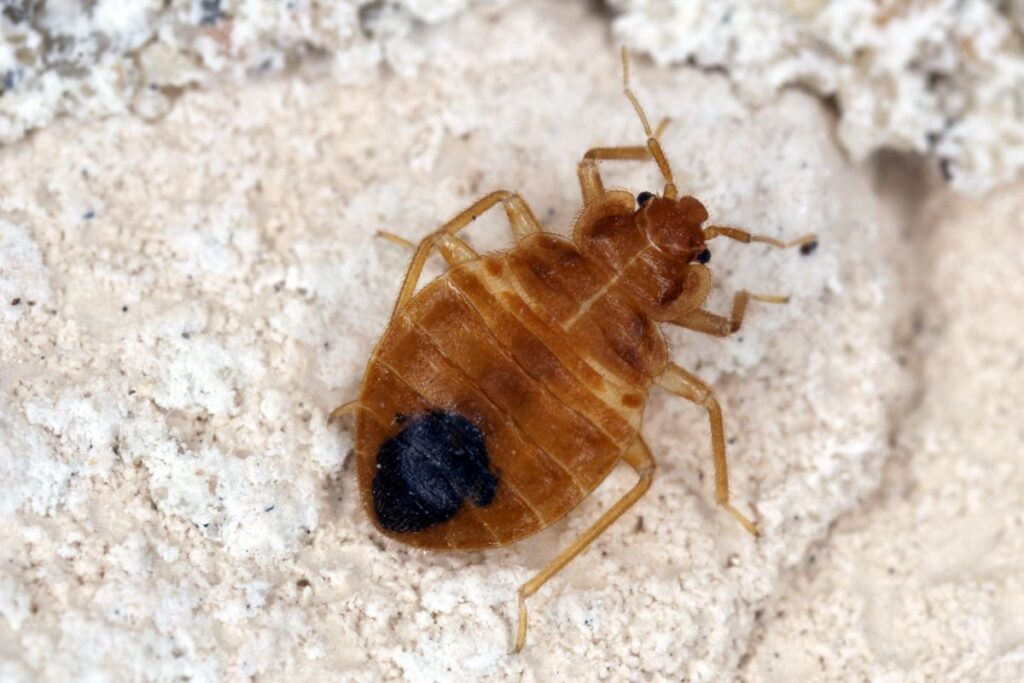
How can I protect myself from bed bugs when travelling?
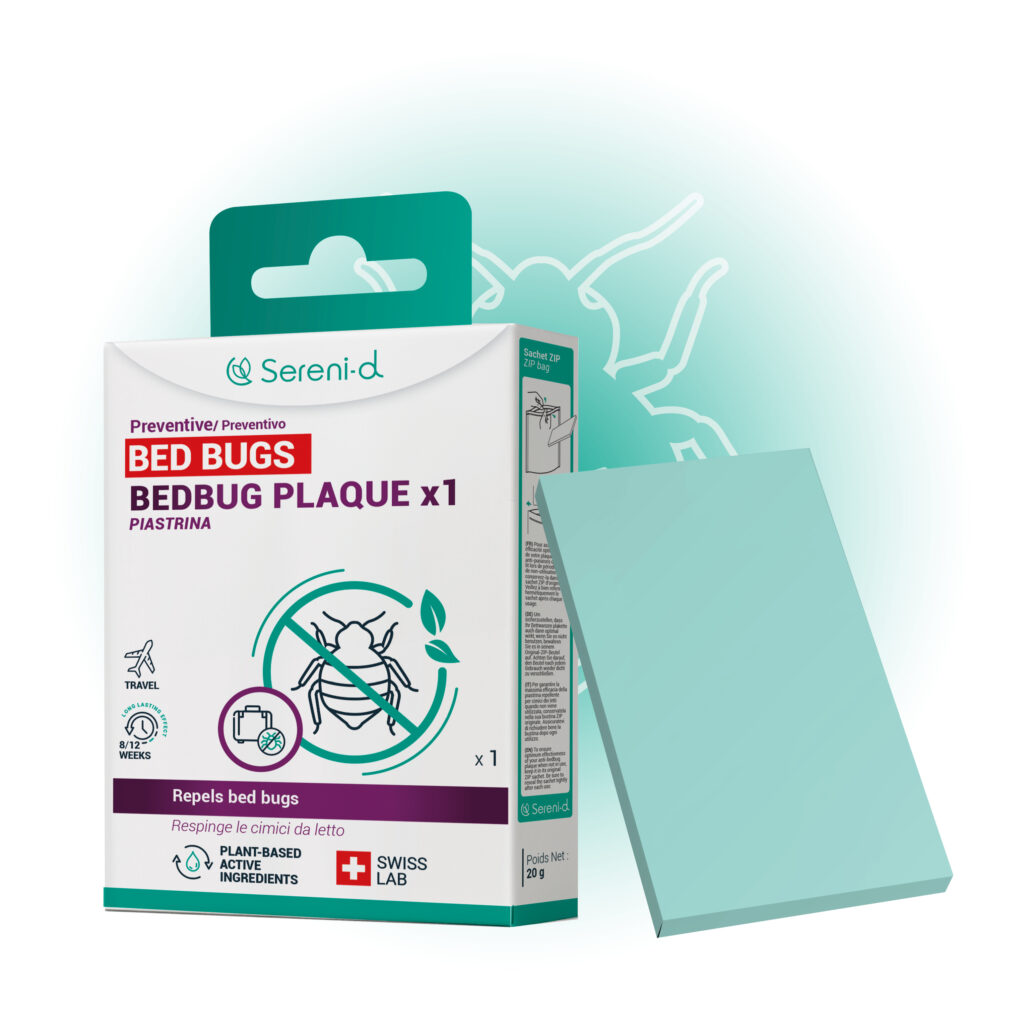
Travel Plaque repellent bed bugs
21.90 €
- Travel repellent plaque against bed bugs
- Repels bed bugs in a preventive context
- Durable, safe, and long-lasting protection
- Over 250,000 satisfied Sereni-d® customers
Pack an anti-bed bugs travel kit
A repellent spray
Use an anti-bed bug repellent spray such as Sereni-d’s SHIELD spray. Spray it on your suitcases and clothes to prevent bed bugs from getting into your belongings and laying eggs. Without being paranoid, prevention is the best way to deal with the bed bugs scourge.
A bed bugs cover with mattress cover
When you’re travelling, it’s a bit cumbersome and not necessarily suitable for all types of trip, but it might be a good idea to bring along a bed bugs cover for your mattress. This can help prevent bed bug infestation by stopping these insects from nesting in your bed. If you use a cover, make sure you install it correctly and do not remove it during your stay.
Repellent pads
Simple to use, repellent pads emit natural or chemical substances that effectively repel these pests. You can place them in your luggage, handbags, rucksacks, suitcases or around your bed.
An excellent accessory for travelling with peace of mind!
Airtight bags
Enclosing your clothes and belongings in airtight bags prevents bed bugs from gaining access or hiding in them. If you suspect an infestation, you can wash or freeze the contents of the bags directly without contaminating the rest of your belongings.
Put your suitcase in the right place
Be careful, bed bugs can easily get into your suitcases if you put them close to their hiding places.
Here are some precautions to take:
- Avoid the floor and bed: Never place your luggage directly on the floor, bed or upholstered furniture.
- Use a metal luggage rack: If your home is equipped with one, place your suitcase on a metal luggage rack, away from walls and curtains. Metal is difficult for bedbugs to climb.
- Choose the bathroom: If no luggage rack is available, place your belongings in the bathroom, on a clean tiled floor. Bed bugs generally avoid these hiding places.
- Store your belongings in airtight bags: For optimum protection, place your clothes and personal belongings in airtight or vacuum-sealed plastic bags, which will prevent the pests from getting inside.
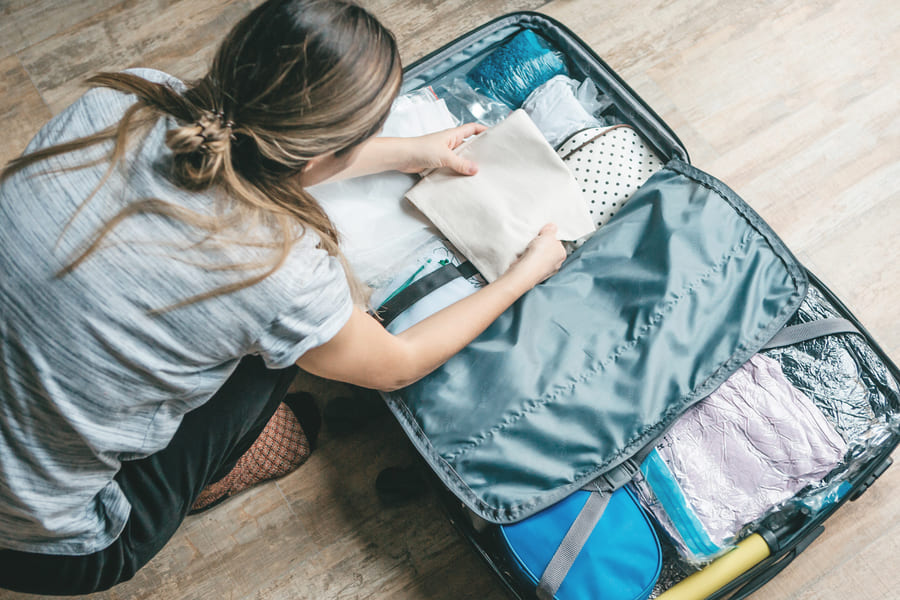
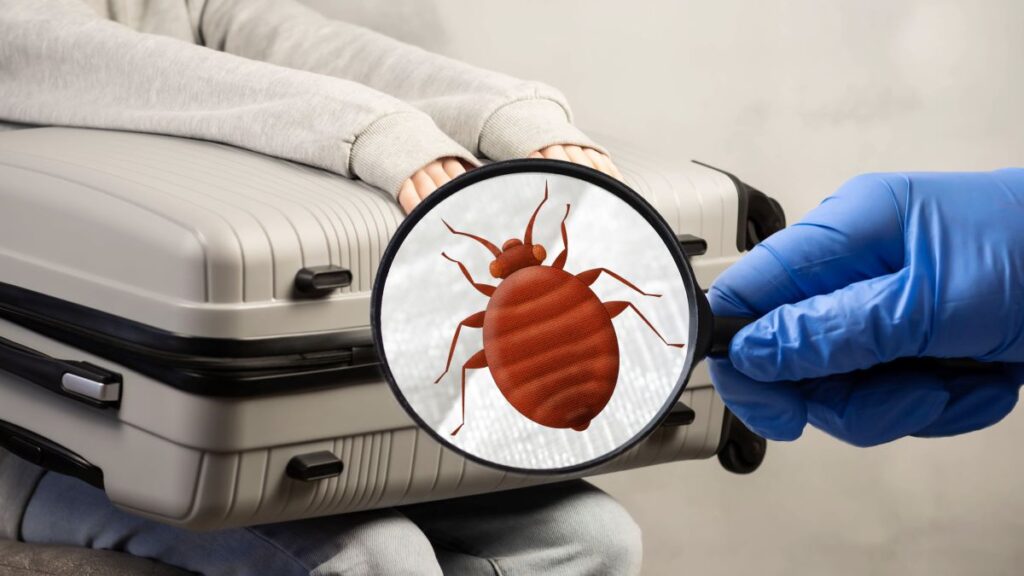
Can you carry bedbugs around with you?
Yes, it’s possible to have bedbugs on you, they can embed themselves in your clothes. During travel, these pests can find their way into our luggage without you even realising it. So it’s imperative to be vigilant to avoid bringing bedbugs into your home. Here are our tips and precautions for maximum protection against bed bugs:
- Backpacks: when you arrive at your hotel or holiday accommodation, place your luggage on a luggage rack, on a high table or on the bathroom floor. Don’t put your suitcase on the bed or on the floor to prevent bed bugs from getting into your belongings. NB: prefer light-coloured, hard-shelled plastic cases to prevent bedbugs from clinging to them; you’ll be able to detect the presence of insects right away. If your luggage is made of fabric, wrap it in a large airtight bag.
- Clothing: keep your clothes in your suitcase, and avoid scattering them on the ground. On the last day of your stay, pack all your clothes in a sealed bin bag.
- Shoes: Place your shoes outside if possible, on the balcony for example.
- Repellent: Using an anti-bedbug repellent is an effective way to protect yourself from bedbugs and avoid bringing them home.
Bed bugs when travelling: what to do when you get home
If you think you may have been exposed to bed bugs during your trip, wash your clothes as soon as you get home. Wash them in very hot water (at least 60°C) to kill any bed bugs and eggs that may be present. You can also put your clothes in the tumble dryer at high temperature for at least 60 minutes, or place them in the freezer for 4 days. You can also treat your belongings with Sereni-d’s SOS Bedbugs spray. In any case, empty your suitcase in a tiled area such as a bathroom, or even better in a white bathtub, so that you can see straight away if a bed bug has fallen out of your belongings.
Wash your clothes immediately on your return
If you think you’ve brought bed bugs home, it’s essential to start treating your belongings as soon as possible. Bed bugs are very difficult to get rid of, and it’s best to act at the first sign of them to treat your home and prevent a major infestation. Remember, prevention is the best way to protect yourself from bed bugs. Sereni-d has developed unique natural formulas made up of essential oils, plants and water, both preventive and curative, to help you deal with the bed bugs scourge without poisoning yourself.

Bed bugs in your suitcase: what can you do?

How can you tell if a bed bug is in your suitcase?
Bed bugs can easily hide in the nooks and crannies of your luggage when you’re travelling. Detecting their presence in your suitcase is vital to avoid bringing them home with you.
Here’s how to find out if your suitcase is infested:
- Inspect the seams and nooks: Bed bugs generally hide in the seams, corners and folds of the lining.
- Look for characteristic marks:
- Black spots (bedbug droppings)
- White eggs (similar to grains of rice) or moults
- Traces of blood
- Watch for bites: If you start to notice characteristic line or cluster bites after your trip, it’s likely that bedbugs have infiltrated your luggage.
Good to know:
Bed bugs can slip into your luggage in a matter of minutes if you put it down near an infested area, such as a contaminated bed or carpet. Acting quickly when in doubt is the best way to prevent an infestation in your home.
Why do bedbugs go into suitcases?
Bed bugs are opportunistic insects that take advantage of suitcases to move from one place to another.
Bed bugs feed exclusively on human blood. When travelling, suitcases are often placed near infested beds or furniture, giving bed bugs an ideal opportunity to get close to their food source, and the seams, folds and pockets of suitcases are ideal havens for these little pests. These dark, narrow areas offer them the protection they need to hide and lay their eggs. Clothes, sheets or other textiles carried in a suitcase offer them temporary shelter.
How do you kill bed bugs in a suitcase?
If you suspect bed bugs in your suitcase, it’s crucial to act quickly to prevent an infestation in your home. Here are the most effective methods for eliminating these pests:
1. Use heat to eradicate them
- High-temperature tumble dryer: If your suitcase is made of fabric, place it in a tumble dryer at a temperature of at least 60°C for 30 minutes. The heat kills adult bed bugs, larvae and eggs.
- Steam cleaner: Use a steam cleaner to clean the entire surface of your suitcase, including seams, pockets and nooks and crannies. Steam should reach at least 100°C for maximum effectiveness.
2. Vacuum the interior and exterior thoroughly
Use a hoover with a fine nozzle to reach seams and creases. When you’ve finished, empty the contents of the vacuum into an airtight plastic bag, dispose of it immediately outside and carefully clean the filter.
3. Apply a natural insecticide
Sprinkle diatomaceous earth in all the nooks and crannies of your suitcase. This natural product dehydrates and kills bedbugs by damaging their outer shell. Leave for a few hours, then vacuum up the powder.
Serenid offers a very effective diatomaceous earth spray.
4. Wash the textiles in the suitcase
Remove and wash all removable textiles (linings, inner bags, etc.) at a temperature of at least 60°C to eliminate any potentially hidden eggs or bedbugs.
5. Use a bed bug spray
Apply a specific bedbug repellent or insecticide spray to hard-to-reach areas such as pockets, zips or handles. Make sure you use a product that is safe for the surfaces of your suitcase.
Additional advice:
After treatment, store your suitcase in an airtight bag or a bed bugs with mattress cover to prevent re-infestation. Also inspect your home carefully in case any bedbugs have escaped.
Hotels, mountain refuges, dormitories, public transport: places frequently infested with bedbugs
Certain places are ideal for the development of bedbugs. This is the case for places with a high turnover of travellers, such as the famous GR20 in Corsica, the Way of Compostela or the Stevenson Way – GR70. Thousands of people travel these roads every year, and the adventure can turn into a nightmare if you don’t take precautions. The same is true of public transport, where bedbugs often proliferate.
Indeed, whether it is the ferries, high mountain refuges, hotels, youth hostels or even Airbnb rooms or holiday homes, they can be infested. Any type of lodging can be affected, from a 5-star resort to a roadside hotel.

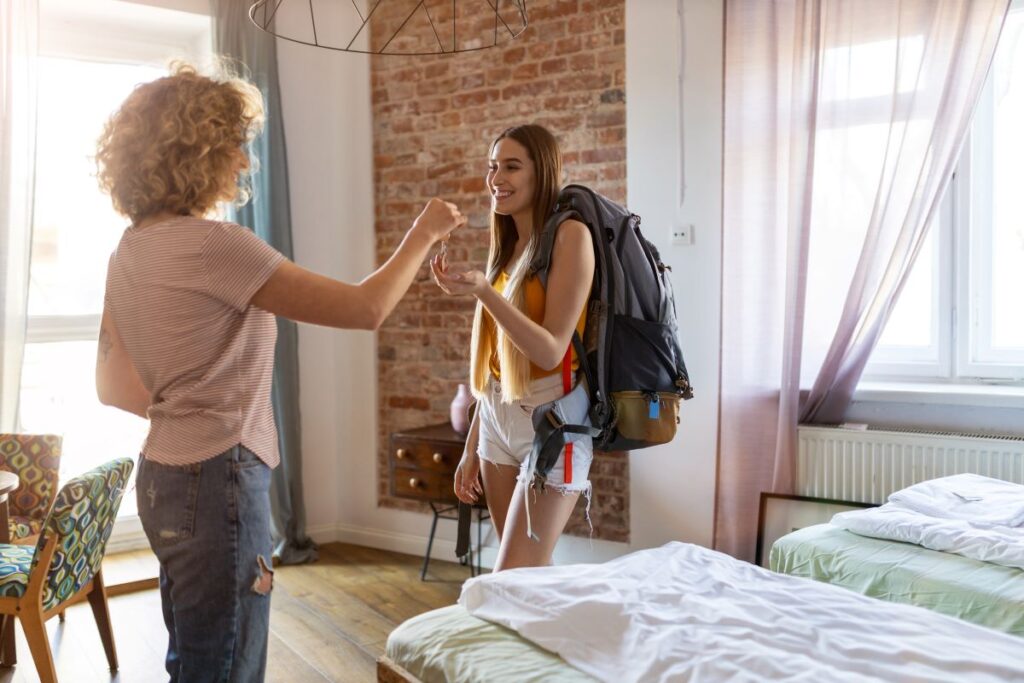
What precautions should you take if you rent out a room or your house on Airbnb?
To avoid and prevent a bedbug infestation if you rent out your accommodation, here are a few tips:
- Choose a minimalist decor with as little furniture as possible. This will give you a clearer picture if a bedbug infestation begins.
- Avoid carpets, and prefer smooth floors, which are easier to clean and less practicable for bed bugs.
- Use a mattress protector with double plastic protection. This will prevent bed bugs from reaching the mattress.
- Wash and dry bed linen. Wash at 60°C to kill any insects. The tumble dryer destroys eggs, larvae and even the toughest bedbugs.
- Vacuum every nook and cranny of the room, and be sure to dispose of the vacuum bag in an airtight bag.
- Place a luggage rack in the room to prevent travellers from putting their suitcases and bags on the bed.
➡️ To find out more: Bed bugs in Airbnb: what can you do?
Sereni-d solution for protection against bedbug bites
Whether you’re travelling, hiking or at home, protect yourself from bedbug bites withSereni-d Anti-Bite Body. This natural repellent spray repels bedbugs as a preventive measure for long-lasting, safe protection.
Formulated with Geraniol extract, essential and plant oils, it will be your ally when you’re on the move or in case of suspected bedbugs.

